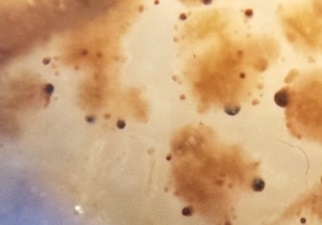


Scientists at the University of São Paulo in Brazil, in collaboration with colleagues at the University of Bath in the UK, aim to find ways of inhibiting gene exchange between fungi in order to reduce resistance to fungicide (image: spore-bearing sexual reproduction structures (cleistothecia) produced by the mutant strain ΔgprH / PLOS Genetics)
Published on 03/23/2021
By André Julião | Agência FAPESP – Researchers at the University of São Paulo (USP) in Brazil have been observing the sexual habits of fungi with the aim of finding strategies to combat species potentially harmful to people and plants. So far, they have discovered, for example, a protein complex that tells the fungus when the environment is not suitable for reproduction.
The results of the study, which was supported by FAPESP, are published in the journal PLOS Genetics.
“Sexual reproduction can be highly advantageous to pathogenic fungi because it favors genetic recombination and enhanced resistance to fungicide, for example. It’s therefore important to understand the sexual dynamics of these organisms,” said Gustavo Henrique Goldman, a professor in the University of São Paulo’s Ribeirão Preto School of Pharmaceutical Sciences (FCFRP-USP) and principal investigator for the project.
The study was part of a collaboration between USP and the University of Bath in the United Kingdom. It was conducted under the aegis of the FAPESP program São Paulo Researchers in International Collaboration (SPRINT). Scientists in the United States also took part.
The model species used by the group was Aspergillus nidulans, which is not harmful to people or plants but is genetically very similar to pathogenic species such as A. flavus (one of the main postharvest contaminants of grain crops) and A. fumigatus (a known cause of hospital-acquired infections in patients with low immunity).
Another project led by Goldman, also with FAPESP’s support, is investigating proteins that protect A. fumigatus from oxidative stress and other adverse conditions.
Sexual inhibitor
In their PLOS Genetics article, the researchers describe for the first time a set of proteins that tell A. nidulans whether glucose is present in its surroundings. If not, the fungus stops reproducing.
A possible explanation for the phenomenon could be the high energy expenditure required for reproduction, so that the signal provided by the protein complex prevents the organism from triggering a process that cannot be completed in the absence of food.
The researchers also discovered that in A. nidulans, so-called “G proteins” indicate the presence or absence of light in the environment. G proteins play a central role in transmitting signals from a variety of stimuli outside a cell to its interior.
If the fungus is in the dark and has access to a food supply, it reproduces sexually, interacting with another individual and sharing genetic material. In the presence of light, it reproduces asexually, releasing spores into the air so that they disperse.
For Goldman, the discovery made in the model species may point to ways of combating pathogenic fungi. “If we can find ways to control gene exchange within a population, we’ll be able to control resistance to fungicides. We can apply a fungicide together with a compound that inhibits the sexual process to reduce the dispersal of resistant varieties in the population,” he explained.
An advantage of the G proteins described is that their action mechanism is specific to the fungus, meaning that the deployment of a method to inhibit them in pathogens would have a low risk of harming crops or people.
The researchers also describe the system that regulates the production of sterigmatocystin, a secondary compound that in species such as A. flavus serves as a precursor of aflatoxins, carcinogenic substances that commonly contaminate crops during production, harvest, storage or processing.
“When we achieve a better understanding of how secondary compounds are produced, we’ll have another way to control the proliferation of this kind of organism in plants and even in people,” Goldman said.
The researchers now plan to study the interactions among the proteins in the system in order to understand in more detail how the fungus interacts with light and exactly how it produces toxins.
The article “GPCR-mediated glucose sensing system regulates light-dependent fungal development and mycotoxin production” (doi: 10.1371/journal.pgen.1008419) by Thaila Fernanda dos Reis, Laura Mellado, Jessica M. Lohmar, Lilian Pereira Silva, Jing-Jiang Zhou, Ana M. Calvo, Gustavo H. Goldman and Neil A. Brown can be read at: journals.plos.org/plosgenetics/article?id=10.1371/journal.pgen.1008419.
Source: https://agencia.fapesp.br/33318